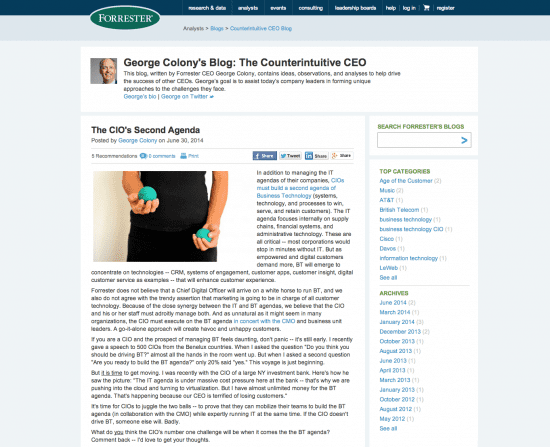Should your CEO be blogging?
Should your CEO have a blog separate from your company’s blog? Although it does depend on sector, it’s an increasingly important question, since many CEOs are emerging (or are already well established) as the 'public face' of the organizations they lead.
Richard Branson (Virgin Group), George Colony (Forrest Research), Mark Cuban (Dallas Mavericks) and Martha Heller (Heller Search Associates) are only a few of the many chief executives who have successfully taken to digital media to communicate on a more informal basis to employees, customers and other stakeholders. Many of these also run a LinkedIn blog shared via LinkedIn Pulse alongside their personal presence.
Pros and Cons of running a blog
Here’s a look at some of the pros and cons for CEOs contemplating a blog of their own:
Pros of CEO blog
These include:
- It gives your company a personal touch. Any effort that helps to humanize your brand should be strongly considered. A personalized CEO blog can convey a deeper understanding among readers about who you are, what your brand stands for and how the organization you lead seeks to realize its goals.
- Offers a great way for the target audience to interact with your company. Prior to engaging you, prospective customers will always go online to learn more about your business. In addition to checking out your products and services (both on the company website and through third-party sites), many people will investigate the CEO’s blog as well. As Daniel Newman, founder of BroadSuite Consulting, notes:
'The CEO of the company has the power to build instant rapport through a blog, since people will gravitate toward what the company leader has to say (so long as the message is positive) and they will feel more connected to the company because of it.'
- An established CEO blog is also a useful tool in the event of a public relations crisis. When a negative incident occurs, the CEO who steps up and promptly addresses it in his or her blog can help defuse the impact of that event — especially when this is combined with other strategic PR damage-control efforts.

Source: Mark Cuban Weblog
- Provides quality and relevant content to engage your target audience. Simply pasting the CEO’s name on the blog masthead isn’t enough. He or she must provide content of value and relevance in order to stand out from the crowd. When such informative content is delivered in the blog, it can spark a lively exchange of views between the chief executive and readers, further deepening the value of ideas discussed.

Source: CIO's second agenda
- Blogging is also an efficient way to communicate a core message about the organization. 'CEOs field the same questions and repeat answers to multiple stakeholders all the time,' says Ashkan Karbasfrooshan, founder and CEO of WatchMojo. 'Sending an article you wrote (and one that was published on a leading and respected publication) is a powerful way to convey the message.'
Cons of the CEO Blog
It's important to be aware of the challenges of maintaining a credible CEO blog, it can be damaging otherwise! Risks to consider include:
- It's a time-intensive undertaking. The strongest negative to CEO blogging is the time and effort needed to make it work. Even a chief executive skilled at expressing herself will need time to come up with ideas and topics and then craft her message in the most concise and engaging way possible.And if your CEO isn’t particularly adept at written communications, the process becomes much more burdensome. One possible solution is outsourcing the content to someone else within the organization or to a freelance Web content creator. But unless that individual is already well versed in the company’s brand and message, more time and effort is needed to bring the CEO and ghostwriter together and to produce the desired content.
- Quality may suffer if the CEO is too busy to commit. It’s important for a CEO interested in blogging to understand that consistency in quality and output are vital towards building credibility. Without a strong commitment to the endeavor, the blog will be negatively impacted and readership will drop off.
- Blog may mutate into a personal branding effort. Occasionally, a CEO blog that sets out to put a human face on a company takes a wrong turn along the way. It can become a platform for the CEO’s personal brand (for example, if he’s a published author and uses the blog to promote his work), in which case the company’s brand is subsumed or even lost in the noise.
'I am of the opinion that CEOs who blog are like schoolboys playing with matches — potentially they could shed some light, but also they may start a bonfire that gets out of control,' says IT industry veteran David Gingell. 'Leave the blogging to the domain experts and to some senior execs and keep the CEO focused on the stakeholders that pay the bills.'
There are enough CEO blogs out there for everyone to make an independent decision as to their worth. Take a look at this list of prominent CEO blogs that attract thousands, if not hundreds of thousands of readers, every day.
In addition to blogging, many CEOs are publishing content as LinkedIn Influencers. Do you think CEOs still need a blog if they’re producing content on LinkedIn, or can blogging and LinkedIn work together?

Thanks to Peter for sharing his thoughts and opinions in this blog post. Peter LaMotte is a Senior Vice President at
LEVICK and Chair of the firm’s Digital Communications Practice. He is also a contributing author to LEVICK Daily, where he routinely writes about social media marketing and online reputation management. You can connect on
LinkedIn.




 Thanks to Peter for sharing his thoughts and opinions in this blog post. Peter LaMotte is a Senior Vice President at
Thanks to Peter for sharing his thoughts and opinions in this blog post. Peter LaMotte is a Senior Vice President at 

